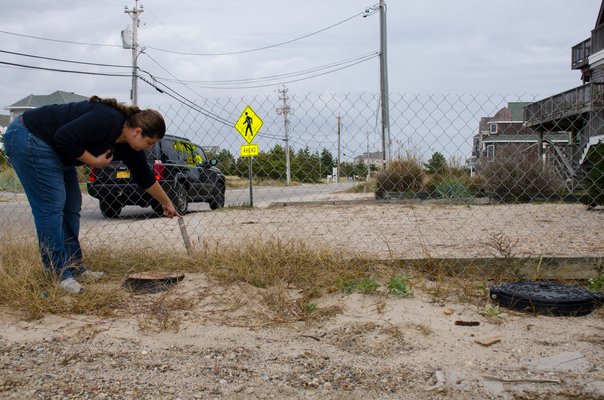
As many as 60 of nearly 300 closely sited summer homes in the Village of West Hampton Dunes may be sitting on a potentially explosive situation—underground liquid propane tanks that fail to conform to state setbacks from houses or property lines.
The issue was originally brought to New Jersey resident Maria Sausa’s attention in April. While having her summer home built on Dune Road—a construction project that began in 2014—Ms. Sausa noticed a number of irregularities and decided to hire a structural engineer to do a site inspection.
“He quickly noticed that hold-downs were not in the correct locations, cross-bracing was missing and the pile foundation failed, amongst other things,” Ms. Sausa said. “I hired a second engineer and he also confirmed these findings.”
Ms. Sausa contacted Department of State Regional Architect Richard A. Smith in February and provided him with the engineer reports and several photos, which eventually led to a meeting in March with West Hampton Dunes building inspector Robert Kalfur, Mayor Gary Vegliante and coastal geologist and West Hampton Dunes commissioner of wildlife protection Aram Terchunian.
Mr. Smith followed up by sending a letter to Mr. Kalfur in which Mr. Smith said he was informed a few days after the meeting that there were a large number of propane tanks that may have been installed as close as 2 feet to property lines. The State Fire Code says liquid propane gas tanks of up to 2,000 gallons must be placed at least 10 feet from buildings, other containers, public ways or the lot lines of adjoining properties that can be built upon.
In the same letter, Mr. Smith said Mr. Kalfur had verified that there were at least four or five tanks that he had approved to be installed too close to property lines, and that there might be many more that were installed before his tenure began in 2013 as building inspector in the small community, which was established in 1993.
In September, Mr. Vegliante sent a letter to all of the oceanfront village’s homeowners to inform them that one or more homes might not meet the state code where the tanks are concerned. Mr. Vegliante told the residents they could either contact their gas company or design professional to move their tanks to a code-compliant location or apply to the Department of State for a variance from the code.
“I believe they aren’t out of code and think the code is very vague,” Mr. Vegliante said last week. “It’s 10 feet from the home it services, and at least 10 feet from the home next door, it should be just as safe.”
However, Mr. Smith indicated in his letter to Mr. Kalfur that the State Department takes the setback requirement very seriously, although it leaves penalties for noncompliance up to local officials. “Owners may seek a variance through the Southern Region Board of Review,” he wrote, “but I believe the board would be very reluctant to grant a variance from such a life safety issue.”
Apparently the problems don’t stop there.
Mr. Smith’s letter pointed to another perhaps widespread discrepancy when it comes to conforming to codes set by the state.
As its name suggests, West Hampton Dunes is located in an area that is prone to high winds and flooding. In order to meet code requirements for high wind design, the homes cannot exceed three stories in height.
“I was informed by you that there are a number of other four-story buildings that were constructed in a similar manner in your village,” Mr. Smith wrote in his letter to Mr. Kalfur. “It is your responsibility to insure that these buildings are also designed and constructed to meet all design criteria.”
Phone calls and emails to Mr. Kalfur seeking comment were not returned last week, and attempts to speak with Mr. Smith were redirected to the Department of State’s press office.
“We have no changes to the statements contained in the letters from Mr. Smith to Mr. Kalfur,” a press officer wrote in an email, “and the letters speak for themselves and are accurate.”
Meanwhile, Mr. Vegliante said the village has hired an engineer to help evaluate the situation with the propane tanks.
“I believe you will find that every one of the homes is safe in the village,” Mayor Vegliante said this week. “I don’t think there’s any home that’s at any great risk.”